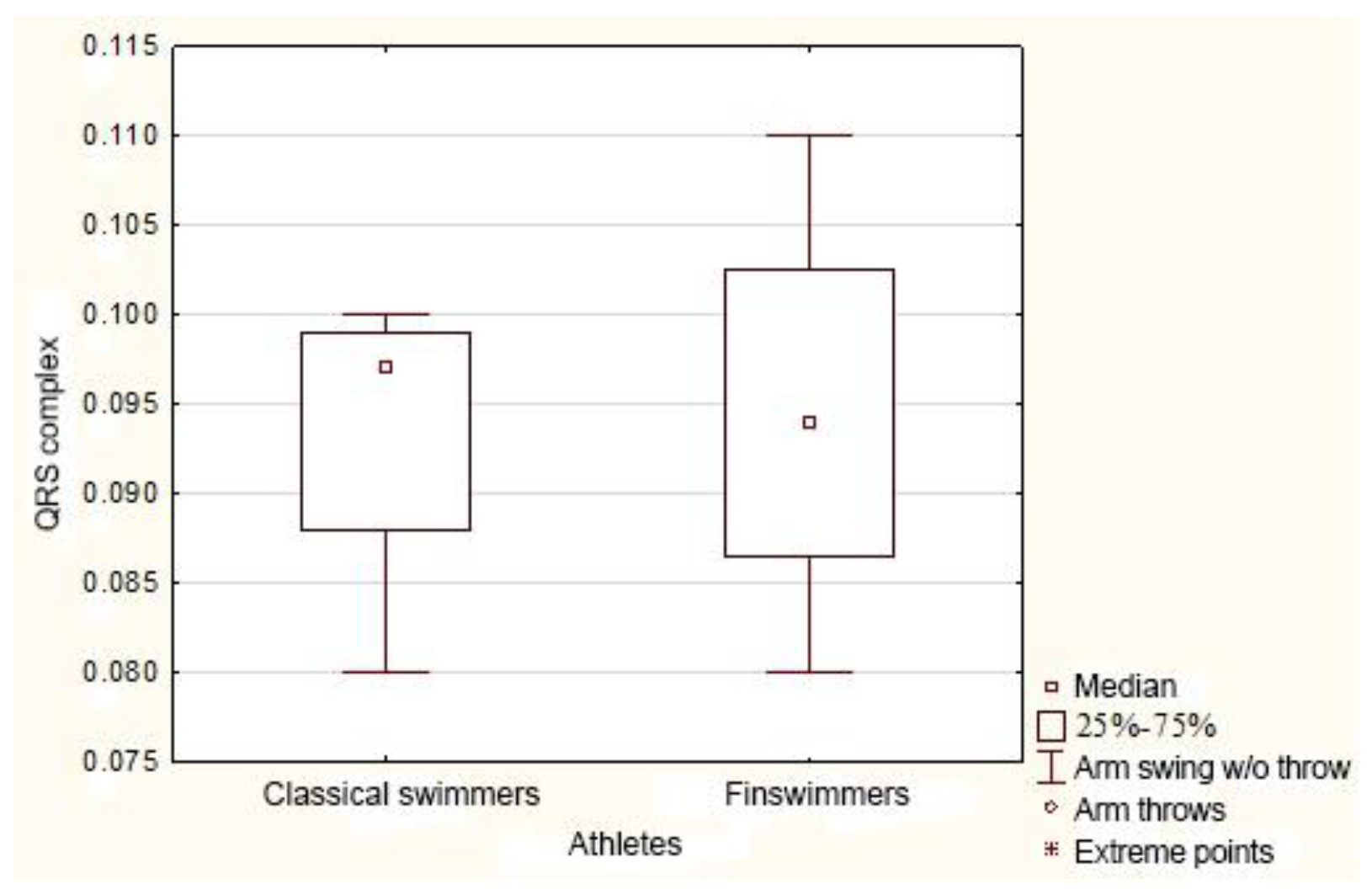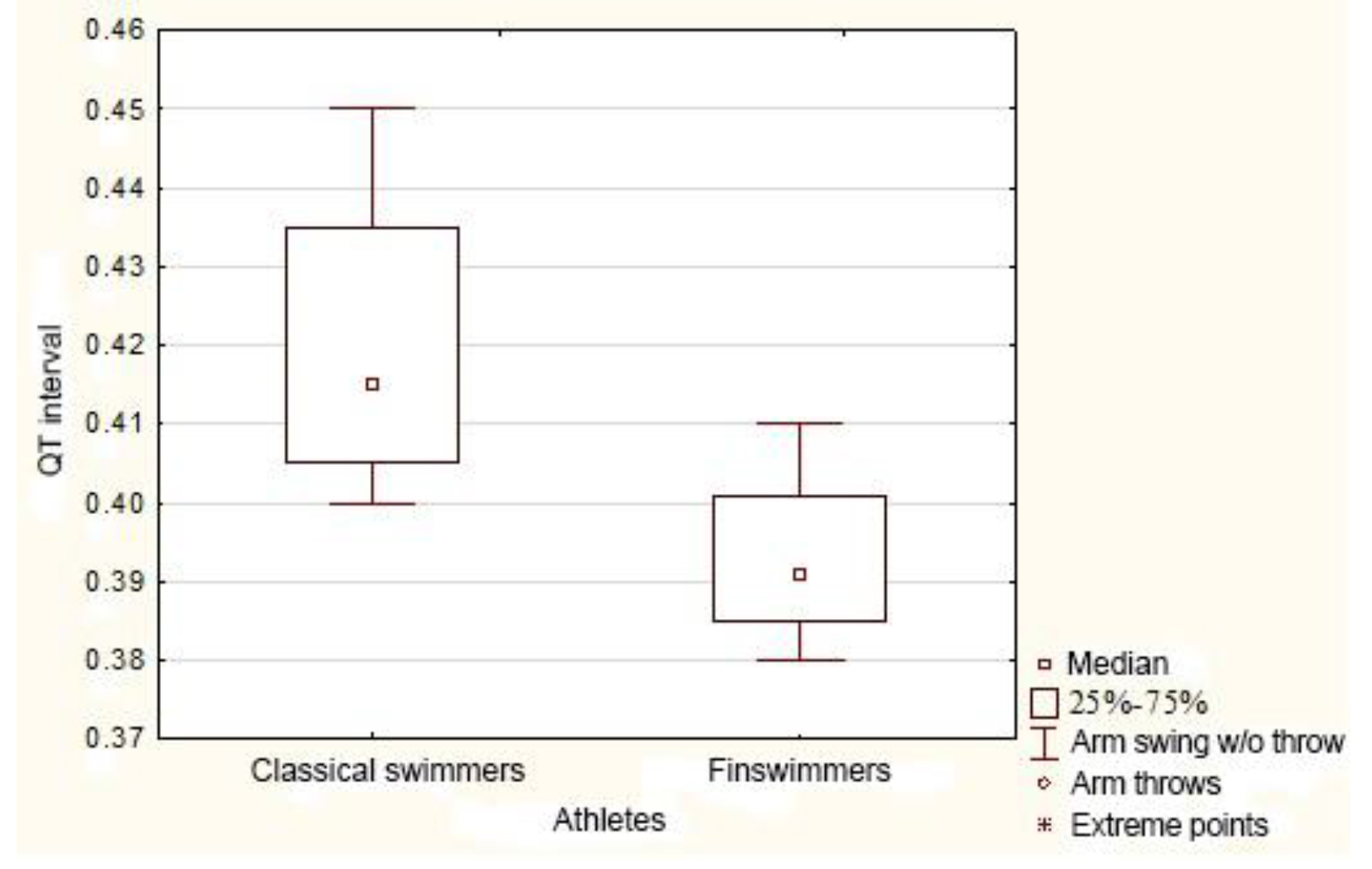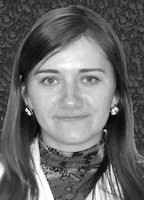Finswimmers' cardiovascular system adaptation specifics
Фотографии:
ˑ:
Dr.Med. E.Y. Dyakova1
Postgraduate A.A. Mironov1
1National Research Tomsk State University, Tomsk
Keywords: adaptation, cardiovascular system, electrocardiography, finswimming, athletes.
Introduction. Recently, underwater sport has become increasingly popular. Finswimming is the most spectacular kind of underwater sport recognized by the International Olympic Committee. Athletes compete not only in swimming pools, but also in open water, and they use watersport goggles, snorkel or breathing air bottle, and fins or monofins as the main inventory [4].
Nowadays, special training, including training with the use of the modern recovery means and techniques, is taking enormous significance in finswimming. This is due to increasing competition between underwater swimmers, improvement and complication of sports equipment, as well as improvement of sports results through optimization of the training process [2, 5].
In terms of the lack of researches in this field, the study of the physiological characteristics of the body of underwater swimmers has become an urgent issue of today.
The research objective was to explore the finswimmers’ cardiovascular system adaptation specifics versus that of the classical swimmers.
Research methods and structure. The study was conducted at the premises of Tomsk State University. The study group (Group A) consisted of 6 elite finswimmers (CMS, MS) of 18-23 years of age with at least 10 years of experience in underwater speed swimming. The reference group (Group B) was made of 6 elite swimmers (CMS, MS) of 18-19 years of age with at least 10 years of experience in classical swimming.
The observations were made at the end of the regular season. To exclude the direct influence of training loads, the studies of the cardiovascular system were carried out on free from training days, during the recovery period.
Blood pressure (BP) was measured using a tonometer.
Electrocardiographic indicators were recorded using the hardware and software complex "Valenta" (LLC "Company Neo", Russia) first – at rest, then – right after physical load – burpee conditioning exercise. This exercise, or rather a routine, consists of three parts: 1) dropping into a squat from a standing position; 2) kicking the feet back into a front plank and immediate return to the squat position; 3) jumping up with arms overhead and return to the standing position.
The electrodes were placed according to the standard circuit.
Results and discussion. Heart rate (HR) was among the first indicators to be measured. In the Group A athletes, average heart rate at rest equaled 63 bpm (58-69 bpm) compared to 60-80 bpm typical for healthy people not doing sports [3]. Bradycardia at rest is among the features of fitness of the cardiovascular system. In the Group B athletes average heart rate at rest was 70 bpm (64-82 bpm).
Heart rate after exercise equaled 80 bpm (75-86 bpm) in Group A versus 98.5 bpm (85-120 bpm) in Group B. This is also indicative of the fact that finswimmers recover faster after exercise, as opposed to classical swimmers.
As follows from the BP measurements, the basic hemodynamic indices in the athletes of both groups are within the normal range, which is typical for healthy people (120/80). The effects of training are expressed in a moderate blood pressure decrease at rest, which leads to more efficient performance of the cardiovascular system (see Table 1). Under physical loads, athletes are characterized by the normotonic prevalent type of reaction marked by:
1) an adequate heart rate increase during intense and continuous work;
2) an increase in the pulse pressure (the difference between the systolic and diastolic blood pressure readings) due to an increase in the systolic BP and an insignificant (within the 10-35% range) decrease in the diastolic BP;
3) rapid recovery of HR and BP to the baseline values after physical loads [3, 1].
Table 1. Blood pressure indicators in athletes before and after physical loads
|
Blood pressure (mm Hg) |
Classical swimmers (mean values and fluctuation limits) |
Finswimmers (mean values and fluctuation limits) |
|
Before physical loads at rest |
||
|
Sistolic |
119 |
116 (107-122) |
|
Diastolic |
73 (60-90) |
70 (60-85) |
|
After physical loads |
||
|
Sistolic |
173 (160-180) |
172 (161-179) |
|
Diastolic |
54 (45-60) |
53 (50-60) |
Electrocardiogram (ECG) decoding analysis showed insignificant changes in the P-peak amplitudes and forms for the Group B athletes. The PQ interval duration (reflecting the atrioventricular conduction) in the athletes of both groups at rest was within the normal range, and after exercise its duration decreased insignificantly in Group B, though remained within the normal range.
The QRS complex duration at rest was within the normal range in the athletes of both groups: 0.08 – 0.1 sec. The high percentage of the QRS complex duration rates can be explained by the fact that it takes hypertrophied myocard a long time to become excited. After physical loads, the results (Fig. 1) slightly changed. The myocardial excitation velocity increased but remained within the normal range:
The QT interval was calculated using Bazett’s formula:
The value of 0.34 – 0.47 sec passes for normal for athletes. The part of the study conducted at rest revealed that the values in both groups were within the normal range. After physical loads, the QT interval increased in the athletes of Group B (Fig. 2), but remained within the normal range. This may testify to the risk of development of pathological changes in these subjects.

Fig. 1. QRS complex duration in athletes after physical loads

Fig. 2. QT interval duration in athletes after physical loads.
The QRS mean resultant vector projection on the frontal plane is called mean electrical axis of the heart (AQRS). In athletes the heart is oriented vertically. Its position is normal in Group B, but there is a deviation in the Group A athletes. This once again proves the development of ventricular myocardial hypertrophy - an indicator of athlete's heart and body adaptation.
Conclusion. The study revealed that all the ECG, HR and BP values in finswimmers and classical swimmers were within the normal range. We detected the peculiarities of the cardiovascular system adaptation to regular physical loads and hypoxia in general. Finswimmers’ cardiovascular system is adapted slightly better than that of classical swimmers. Underwater swimmers recover faster after physical loads, they have moderate heartbeat, though their heart rate is decreased.
References
- Vikulov A.D., Shevchenko A.Y. Trenirovochny protsess i serdechny ritm [Training process and heart rate]. Meditsina i sport publ., 2005, no. 8, 32 p.
- Vildeboer P.E. Podgotovka Lotte Friis. Plavanie [Training of Lotte Friis. Swimming]. 2011, pp. 57-61.
- Dembo A.G., Zemtsovskiy E.V. Sportivnaya kardiologiya [Sports Cardiology]. Leningrad: Meditsina publ., 1989, 495 p.
- Shumkov A., Shumkova L. Azbuka plavaniya v lastakh. Ch. I [Finswimming ABC. Part I]. Moscow: Azbuka 2000 publ., 2009, pp. 6-9.
- DoXam, Aklas Hussein. Vliyanie vysokoy intensivnosti trenirovok na plovtsov v sorevnovaniyakh dlya igrokov na vysshem urovne [Effect of high-intensity training on swimmers' performance in top-level competitions]. Pedagogicheskoe obrazovanie v Rossii, 2013, no. 5, pp. 58-61.
Corresponding author: adyakova@yandex.ru
Abstract
The study was designed to explore the finswimmers’ cardiovascular system adaptation specifics versus that of the classical swimmers. The study found the finswimmers’ heart rates at rest and after exercise being lower than that of the classical swimmers, with the blood pressure rates in both of the groups staying within the normal range. ECG decoding analysis showed insignificant changes in the P-peak amplitudes and forms for the classical swimmers. The QRS complex duration rates were dominated by 0.08 – 0.11 s; the QT interval rates of the groups were within the normal range; and no pathologic disorders were found in the athletes.



